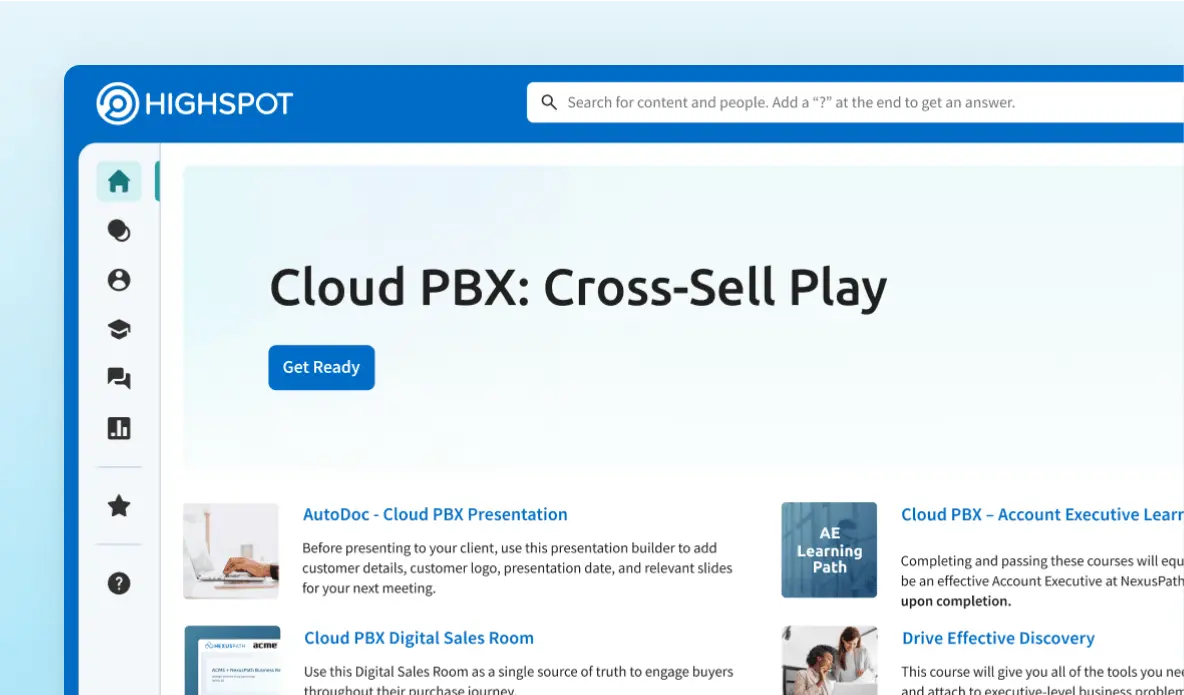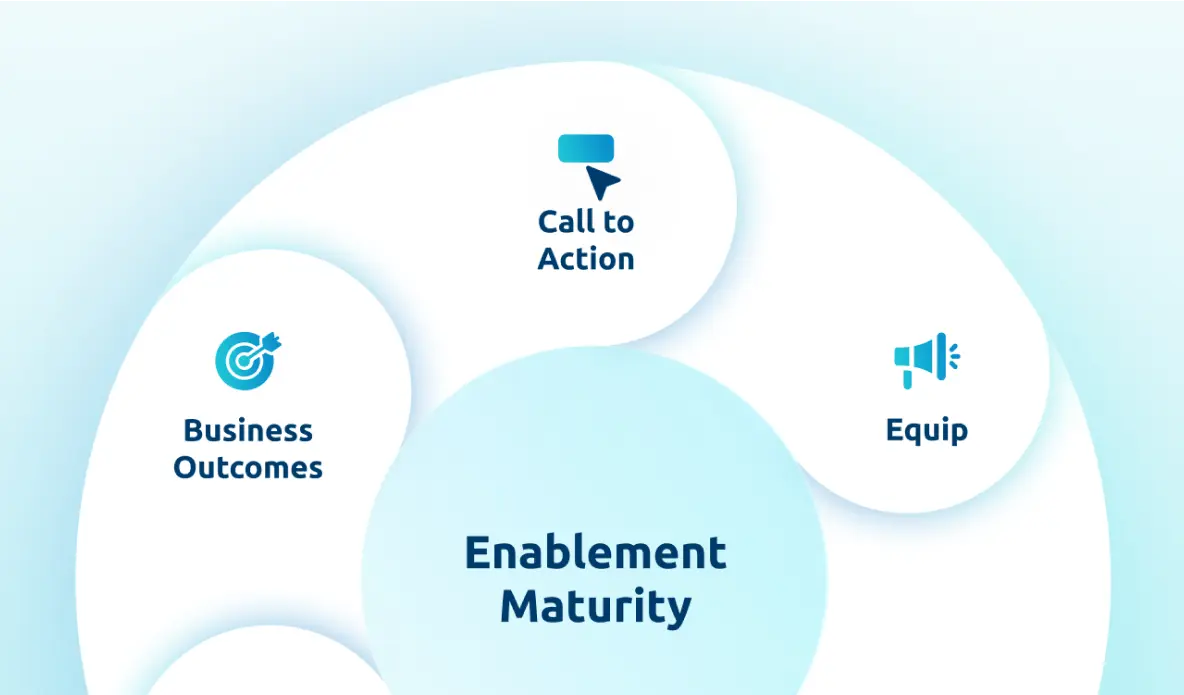Bunge’s marketing manager details how onboarding AI-powered GTM solutions like Highspot have helped his team better execute.
According to research from Harvard Business Review, only 28% of executives believe their organization’s strategies were understood and executed effectively. So, how can you effectively define, execute, and optimize your go-to-market initiatives with your enablement tech stack?
Shawnna Sumaoang: Hi, and welcome to the Win-Win podcast. I’m your host, Shawnna Sumaoang. Join us as we dive into changing trends in the workplace and how to navigate them successfully.
Here to discuss this topic is Zoran Vulic. Thank you for joining us, Zoran. I’d love you to tell us about yourself, your background, and your role.
Zoran Vulic: Thanks for having me. I appreciate the opportunity.
My name is Zoran Vulic. I work at Bunge in the North American Oils Group. Been with the organization for about nine years now, focused on communications and digital strategy and have been somewhat new to the food space, which is fun’s wheelhouse. So I’m kind of someone that’s not necessarily a typical marketer that’s in the food space.
I’d probably classify myself as a digital native first in that space. So a little bit different and so. When I came to the organization with Bunge, they were looking to change some of their go-to-market strategies. They’re come a little bit stale and wanted to increase some of the value that we offer our customers and looking to expand into different markets and be able to service our customers in different ways.
SS: Amazing. Well, I’m glad that you are with the organization and joining us today on this podcast as a marketing leader, what are some of the key go-to-market initiatives that you’re focused on driving this year, and what business outcomes are you aiming to impact through these initiatives?
ZV: We focus on, or we service two main customer subsets within the North American Oils Group, one of ’em being food manufacturers and the other one being our food service operators.
These are closely aligned with our annual go-to-market strategies and our annual commercial initiatives, and they’re really focused on expanding our products in adjacent markets. Launching new products within our target market groups, focusing on markets where we know that there is high growth potential, and then offering solutions across the entire value chain.
So from, you know, your lowest commodity products, all the way up to your value added products. And these outcomes are really closely aligned with our annual go-to-market strategies, which we collaborate with all the different business functions within our organization, within the oils group within North America.
SS: Amazing. And I love how you are aligning kind of your strategies with the organization’s goals. I think that’s amazing, and I know it’s one of your strengths, especially as you kind of analyze how they’re doing. What are some of your best practices for ensuring this alignment as you execute your go-to-market initiatives?
ZV: A long, long time ago, one of my managers at a different organization had this quote that he offered me because I was very, very ambitious and very eager and anxious to get going and moving quickly. And he said to me, he said, Zoran, if you want to go fast, you go by yourself. If you want to go far, you bring other people with you.
And so I’ve really lent into that, which is in order to get all the organization rowing in the same direction, we need to be able to socialize these plans. So part of our process is meeting on a quarterly basis and when we’re doing our planning. For 2025, we met as an organization, all the different functional groups.
And we talk about these are the plans that we have that we’re going to execute on in 2025, and here’s why they make sense. And then here are the different functions and here are the different tasks at each of those different groups. So we’re talking about sales marketing. Customer service, supply chain, product line management, all understanding that these are the key initiatives that we’re going to be executing on in the coming year.
And here is how you know the flow of activities is going to happen. This has kind of been a project of mine is also taking a data-first approach to this, which is really looking at, okay, what information or what data do we have available to us that can help us inform. How we’re progressing? Are we trending in the right direction?
Are we trending in the wrong direction? And very simply do more things that work and do less things that don’t work. And when you use data, you take away the emotion from it, and it allows you just to be more. Simplified in your approach in terms of how you can make some of those changes as you’re executing these strategies.
SS: I love that. And I know a key initiative you’re focused on is your annual category-specific commercial initiatives. Can you share more about this effort and the outcomes that you’re aiming for and how you plan to leverage Highspot initiatives to support it?
ZV: Yeah, so when we implemented Highspot, one of the things that really led us to this particular solution was how structured the approach was in terms of how we leverage the tools that are available to us. And so for some of our commercial initiatives, we’re looking to move people up a value chain. Very simply put, how do we move them from one particular product to another particular product that meets their needs in that inherently the customer sees value in part of that comes through, number one, socializing the information to the different stakeholders that need to be aware.
So those include a lot of those different functions that I was talking about previously to you, which was supply chain management, product line management, sales, marketing, customer service. On top of that, what we’re gonna do is now we’re going to, again, teach our sellers, or at least provide them the information that they need to educate themselves on why is this important to their customers.
After we’ve done that, it’s now, okay, what are the key messages that we want to communicate to those customers? And then very simply, what is it that we want to show them? What are our proof points that allow us to validate the claims that we’re making? And then what are the specific tools that we have enabled for our sellers to be able to do that across all the different categories and across all the initiatives?
So we’re really standardizing that approach. And then based on the market that we’re speaking to, we’re providing customized, personalized solutions specific to that audience. That audience is both internal, so the people that are working on behalf of this particular initiative, then the information is really personalized and geared towards that external audience as well.
SS: I love that. And you talked about this, you touched on it a little bit, how a key part of building an initiative in Highspot is really making sure that you’re aligning on the materials you’re using to drive the outcomes. You touched on ’em a little bit, like plays, digital rooms training. Can you share how you’ve identified the resources that you’re using to support your initiatives, like the annual category-specific commercial initiative?
ZV: Yeah, so when we talk about those annual category initiatives, a lot of the time it’s what type of information is the seller going to need in order to communicate this directly to the customer. And then from that position, we then take a look at, okay, what does the customer know and what does the customer not know?
Meaning is this a complex problem that they have? And does this require certain materials? Does this require video in terms to explain a very intricate processes that requires a little bit more knowledge and education building versus, you know, some of the more simplified versions, which are, what is the content that we need to get in front of a potential customer to, again, explain the value proposition of what problem we’re solving for them?
So we’ll do an audit of what specific materials do we currently have within our database? And then understand whether this is going to be a new build, or do we have something that we can fast adapt where we have information that is about, you know, 60% relevant and we have to do a little bit of personalization specific to the category.
Or the initiative that allows us then to get to market a little bit quicker. It also helps, I’ll say this, it also helps because you can then start focusing your dollars, so your marketing budgets more efficiently, because now I’m focused on dollars that are specifically to attract customers rather than developing some of those materials.
So those are some of the relevant pieces we look at when we’re trying to come up with these strategies.
SS: Got it. And you recently started using the initiative scorecards to measure the impact of your go-to-market efforts. How are you using or planning to use these insights to assess the performance of your initiatives and, and really optimize your go-to-market success?
ZV: Yeah. So when initiatives came out, my colleague Paul Higgs and I, were in Seattle for the Spark Conference last year in 2024. And when it got rolled out, I elbowed Paul when we were sitting in one of the sessions and I said, this is it. I can now align this with campaigns. I really hope they’re gonna tell me that I can align this stuff with campaigns, and I know that Highspot is working on that, but really that’s, you know, because I’m looking at it from like an end-to-end solution.
So what information are we doing or what activities are we doing to help inform customers at the begin, which is, you know, really building that pipeline for customers, whether they be existing customers that people that we know, or they’re new customers that we’re trying to attract. And then as we push them through that funnel, we’re, you know, getting some engagement with them.
We’re communicating with them, whether that be on a digital platform or not. And then once we’ve warmed those leads up, or once we’ve provided some of that context to the sellers, any of those leads that now have converted where they’re looking for some type of sales outreach, we’ve now got a plan. Which is our sales play that the sellers can then leverage.
And so then we can measure that activities all the way through. So now I can say, okay, a year from now when we’re looking at launching a new product in a new specific market, I’ve now got some data to say, here’s the type of effort that’s gonna be required in order to get the results that we’re looking for.
And previous to this, we didn’t have that. And so this is like quite a big win for us in terms of the Marco function, which is we can really partner with the business and say, you know, and provide some insights to them that, that now go from, you know, from ideation all the way through to commercialization and opportunities that are now being won and customers that are purchasing the product and having some success with it, we’re now able to say, okay, here’s the effort that’s gonna be required. And again, communicating that throughout the organization, through a system like our CRM system is Salesforce.com.
So again, like that close integration between those two, that was obviously a big selling feature for us of making sure that we keep all that information within the same ecosystem because it allows for decisions to be made in a quicker, more streamlined fashion.
SS: Absolutely. How are you going about socializing and actioning the insights that you’re starting to glean from the Initiative Scorecard?
ZV: I’m gonna say I’m probably pretty lucky in this respect where part of our organization we have. Business planning meetings that we have on a monthly basis, and part of those business plan meetings is we socialize and we communicate the results from these initiatives that we have. So it’s already built in.
The good thing is, is that I’m not telling necessarily a story. I’m providing data. And then providing context around the data. So the data is the story, and now what I’m doing is simply providing the context to say, Hey, this is why these initiatives are moving in this direction. These are why these initiatives are moving in this direction.
Here’s the course correction that we would need. And again, that’s a collaborative approach. So. All the different functions are in there, so it comes across as quite collaborative within the organization where we’re all singing from the same song sheet and all rolling in the same direction.
SS: I think that that is an amazing win in and of itself.
And long term, what value do you believe the initiative scorecard can bring to your organization? How do you see it helping you achieve your goals?
ZV: Number one is very much aligning. I. Our go-to-market strategy with the initiatives that we understand that the organization has identified as being the ones that are going to be key on an annual basis.
Then having those key initiatives merchandised in an initiative, and then that initiative attached to a sales play, a sales play that then has all the different assets that all of that stuff is now rolling up. So now we can take a look at all that effort that we’ve. Communicated and created specifically for end user customers and then also our internal customers.
So our sales teams and any of the other functions that need to be aware of the initiatives. All that rolls up together and now we’re able to communicate that out to the audiences.
SS: Amazing, amazing. I love that. Since implementing Highspot, what business results have you achieved and do you have any wins you can share?
ZV: Yeah, there’s a couple wins I can share. I’d say the biggest win for us internally within our sales org is we had a very decentralized process in terms of where materials were stored and housed and, and how sellers would actually access it. And as a result of that, we had a lot of noise within the Marco function of sellers and sales directors, where can I find this? Where can I get this? How do I get this? How do I get that? That has virtually been eliminated, which in and itself allows any of the functions that are working on these commercial initiatives now to focus more their attention on, okay, analyzing results, understanding where we have.
Gaps in our portfolio in terms of what information we can provide our sellers, which then roll up to our customers. And I’d say like the, the secondary one now that we’re, myself and Paul are working on, is really embedding this in the ways that we work. So really focusing on how can we deliver some of these.
Materials and these insights and these assets directly to our sellers in the systems that they operate in. So a little bit of a uphill climb, I would say, for our sellers in that we’re transitioning more to a Salesforce-driven operation versus more of the traditional telephone email. Processes that they’ve been involved in, there has been some noticeable changes.
So one of the things that I can absolutely share with you is that since implementing Highspot, we have seen a 36% increase in our win rate. When we have our sellers share content through the system, we’re looking obviously to expand on that. Coming in the rest of 2025 and then really, really drive home the sales plays that we are utilizing that support those commercial initiatives.
And again, we’ve got very good alignment from the executive team in that they all understand that this is where the sellers and any of the functions that are involved in working on the commercial initiatives, this is where all the information is going to be stored and this is how it’s gonna be, uh, communicated out to our customers.
SS: Amazing. Last question for you, Zoran, to close. What is the biggest piece of advice that you would give other marketing leaders looking to lead go-to-market initiatives that really deliver measurable outcomes?
ZV: Get alignment with your executive team. That is the biggest aha moment I had when we were implementing Highspot.
And then once we implemented, once we understood how this could alter and guide our sales process. To support these commercial initiatives. It was very much like hand-in-glove type of, uh, alignment where the initiatives are being communicated to the various groups that are supporting them. And then we’re providing those assets to support those initiatives in a manner that makes it efficient.
And I think that’s kind of like the biggest thing is where you can gain efficiencies. You should because there’s the one commodity that you can’t buy, which is time. And then the other commodity is people’s attention. So if you can get people’s attention, because these are the things that are important, and if they’re important to the executive team, that likely means they’re gonna be important to the people that report into the executive team, so that definitely helps. That would be probably my biggest piece of advice get alignment with your executive team and be very, very clear about here’s how this particular solution can help meet those goals that you have.
SS: I love that. And to your point, having that conversation underpinned with the data just makes it a much more real conversation that the business can then optimize again. So I love that advice. Thank you again so much for joining us. I really appreciate the time.
ZV: Thank you for having me.
SS: To our audience, thank you for listening to this episode of the Win-Win podcast. Be sure to tune in next time for more insights on how you can maximize enablement success with Highspot.




